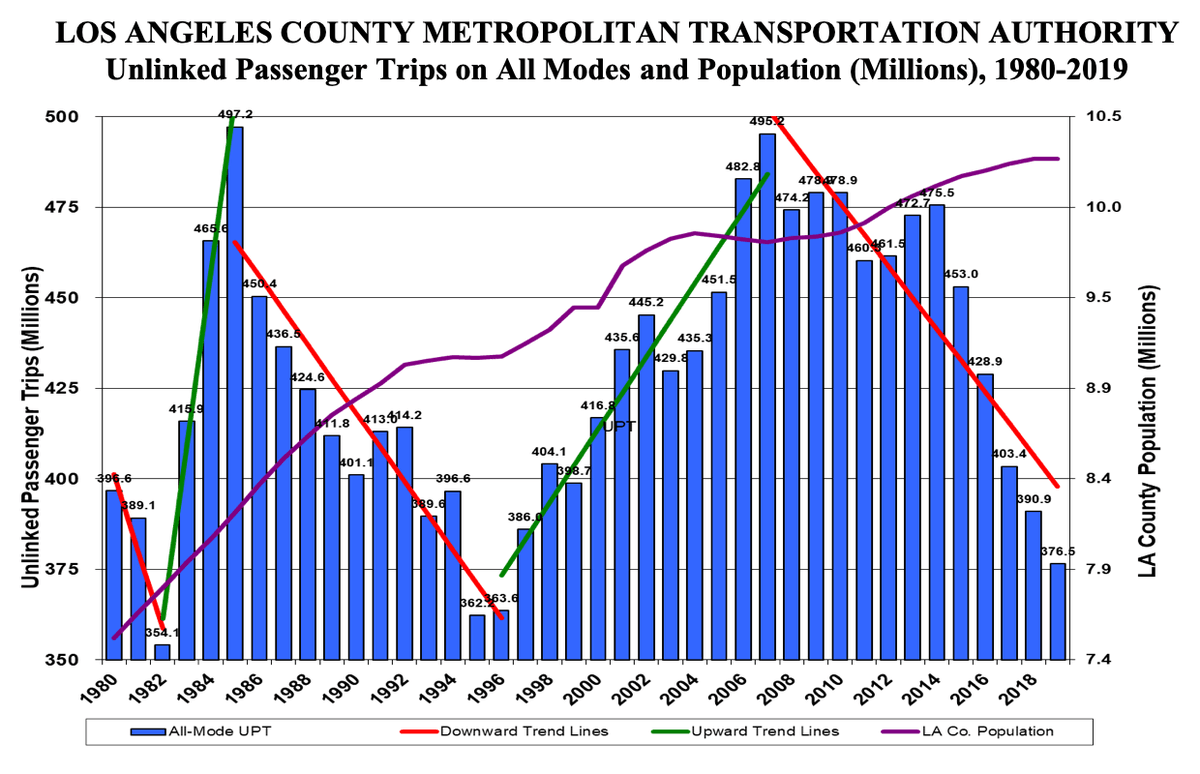So a set of thoughts about urban transport - partly in light of people& #39;s preferences, partly a "post-corona" take and partly a continuation of my view that transport planning isn& #39;t good enough 1/
As you know I& #39;ve a feeling transport planners are trying to make the cut in The Open playing with just an eight iron and a putter. Everything is filtered through "cars are bad" and "mass transit is the future" perhaps with a nod to "more active transport" 2/
One of the best recent reviews of this problem is this look at the history of Los Angeles - a city built for the car - mass transit travails.
https://bit.ly/2Xm6lcY ">https://bit.ly/2Xm6lcY&q...
https://bit.ly/2Xm6lcY ">https://bit.ly/2Xm6lcY&q...
In pretty (and literally) graphic terms the article sets out how directing investment to light rail (tram, metro, rapid local rail) has had a dramatic and negtive impact on ridership.
LA has seen its population rise by over 3m since 1980 but today has fewer public transport users than back then - despite spending billions of dollars on new rail infrastructure.
What happened in LA is reflected elsewhere - money is shifted from road infrastructure into rail, tram and light rail systems with the result that, despite flag-wavingly high profile gains in passenger numbers on these rail systems, ridership across the whole PT system plummets.
We see glimmers of good thinking - here& #39;s a useful review from Joe Peach (drawing on Edinburgh) looking at rideshare, jitney and minibus uses driven by mobile apps. https://bit.ly/3gkIN0C ">https://bit.ly/3gkIN0C&q...
The problem with this app-based systems is that legacy parts of urban transport - especially licenced taxis - actively lobby to prevent such ideas taking hold. We see this across the US, in London and in a variety of European cities.
We see a similar lobby (and the same "safety" argument) in resistance to driverless rail systems despite them having a good record in Singapore and on London& #39;s DLR.
There is a strong case for limiting accress to city centres by larger vehicles with much more pedestrianisation. Emerging (if not entirely new) technologies like e-scooters, e-bikes and even improved mobility scooters all support this shift.
But this requires a more creative approach to shifting from a car to an active mode (bike, walk, run, e-bike) than either suburban park-and-ride or the more common "just ban cars"
The case for city centre perifery low cost car parking is a strong one - linked to active transport and zero emission modes. This should be deliverable in conjunction with other land uses on a subsidy-free basis
Beyond the city centres, the story is different. Most journeys (pushing 90% on an average day) are on roads and most of these are in cars. The dispersed nature of people& #39;s activity (work, leisure, family) makes public transport systems ineffective.
It& #39;s true we can encourage active travel options - especially as people remain hesitant using public transport - but as electirc and hybrid vehicles increase market share the anti-car argument reduces.
I would like a debate about moving to a default position (enforced) where there is no on street parking and to explore how existing property without parking can have its parking needs met off the roadside.
All of this links closely to the debate about housing (how and where we meet housing need) and land supply. Transport systems suffer as much as housing from the problem of artificial constraint on land supply.

 Read on Twitter
Read on Twitter


